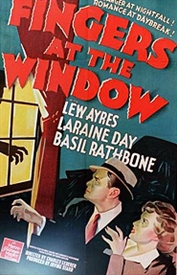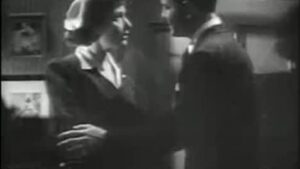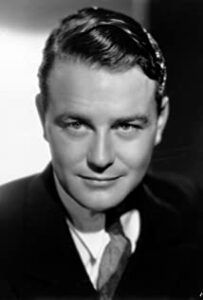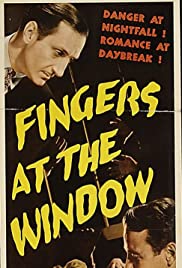Fingers at the Window *** (1942, Lew Ayres, Laraine Day, Basil Rathbone) – Classic Movie Review 11,163
‘DANGER AT NIGHTFALL! ROMANCE AT DAYBREAK!’
Lew Ayres described director Charles Lederer’s 1942 MGM black and white film noir mystery chiller Fingers at the Window as ‘the kind of picture actors do when they need work’, but it is not really that bad.
Chicago is being terrorised at night by a notorious axe murderer. An evil hospital psychiatrist, Dr H Santelle (Basil Rathbone), hypnotises the psychiatric hospital lunatics into committing murder so that he can inherit a fortune. But it all goes hideously wrong because on his trail is spunky unemployed actor Oliver Duffy (Ayres), helped by his pretty dancer friend and sidekick Edwina Brown (Laraine Day), whom he meets and helps while she is being chased by what appears to be a madman.
The film swings uneasily from horror to tongue-in-cheek humour and never quite settles down to provide the shocks it suggests early on. But the nice MGM cast is an asset: Rathbone is very stylish even in such lesser fodder, Ayres and Day are sprightly, genial presences, and James Flavin, Charles D Brown and Cliff Clark are enjoyable as the cops on the case.
Also in the cast are Walter Kingsford, Miles Mander, Russell Gleason, William Tannen, Mark Daniels, Bert Roach, Russell Hicks, Charles Waggenheim, Robert Homans, Iris Adrian, Wally Cassell, Mary Currier, Ray Teal, Rand Brooks, Emmett Vogan, Edwin Stanley, Milton Parsons, Eddie Parker, James Millican, Ralph Dunn, Byron Foulger and Arthur O’Connell.
Fingers at the Window runs 80 minutes.
But it was World War Two. Lew Ayres’s role as Paul Baumer in All Quiet on the Western Front (1930) was his big break and was deeply affected by its anti-war message. Lew Ayres said: ‘To me, war was the greatest sin. I couldn’t bring myself to kill other men.’ He changed his military status from conscientious objector to non-combatant in April 1942, infuriating MGM, and Fingers at the Window was his last film for MGM and his last film until The Dark Mirror (1946) after his service as a medic and chaplain’s aide in the Pacific in World War Two..
Despite the controversy, business was brisk and Fingers at the Window was profitable for MGM. Costing $320,000, it made $288,000 in the US and Canada and $260,000 elsewhere (for a total of $548,000), though somehow only making a recorded profit of $29,000.
MGM then re-shot the Dr Kildare film Ayres had just completed, removing him from the cast. It was called Born to Be Bad. After principal shooting had been completed, MGM scrapped his footage, replaced Ayres as Dr Kildare with Philip Dorn as Dr John Hunter Gerniede, and changed the title to Calling Dr Gillespie. MGM might have feared adverse publicity, but many people admired Ayres’s honesty and courage in jeopardising his movie career for the sake of his principles. Without Ayres, the Dr Kildare franchise never regained its previous popularity.
Fingers at the Window is directed by Charles Lederer, runs 80 minutes, is made and released by MGM, is written by Rose Caylor and Lawrence P Bachmann, from a story by Rose Caylor, is shot in black and white by Harry Stradling Sr and Charles Lawton Jr, is produced by Irving Starr and is scored by Bronislau Kaper.
The cast are Lew Ayres as Oliver Duffy, Laraine Day as Edwina Brown, Basil Rathbone as Dr H Santelle, Walter Kingsford as Dr Cromwall, Miles Mander as Dr Kurt Immelman, Charles D Brown as Inspector Gallagher, Cliff Clark as Lt Allison, James Flavin as Lt Schaeffer, Russell Gleason as Ogilvie, William Tannen as Devlan, Mark Daniels as Haguey, Bert Roach as Krum, Russell Hicks as Dr Chandley, Charles Wagenheim as Fred Bixley, Robert Homans as Officer O’Garrity and Byron Foulger as Bird Man, Iris Adrian, Wally Cassell, Mary Currier, Ray Teal, Rand Brooks, Emmett Vogan, Edwin Stanley, Milton Parsons, Eddie Parker, James Millican, Ralph Dunn, and Arthur O’Connell.
Distinguished Charles screenwriter Lederer directed only three films: Fingers at the Window (1942), On the Loose (1951) and Never Steal Anything Small (1959).
© Derek Winnert 2021 Classic Movie Review 11,163
Check out more reviews on http://derekwinnert.com





